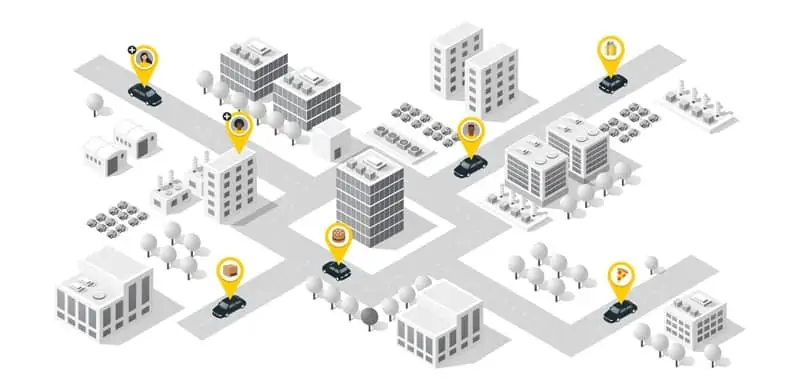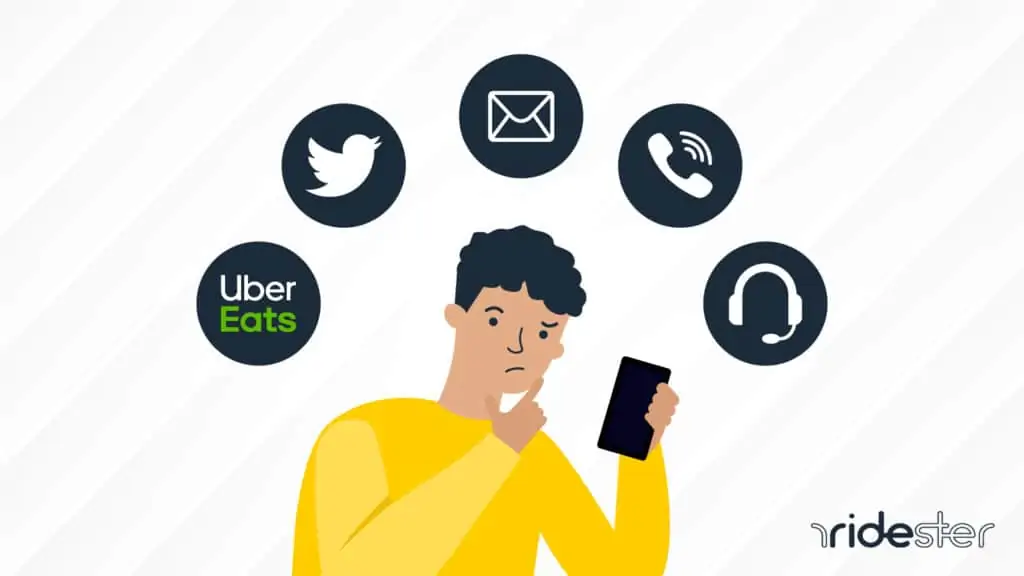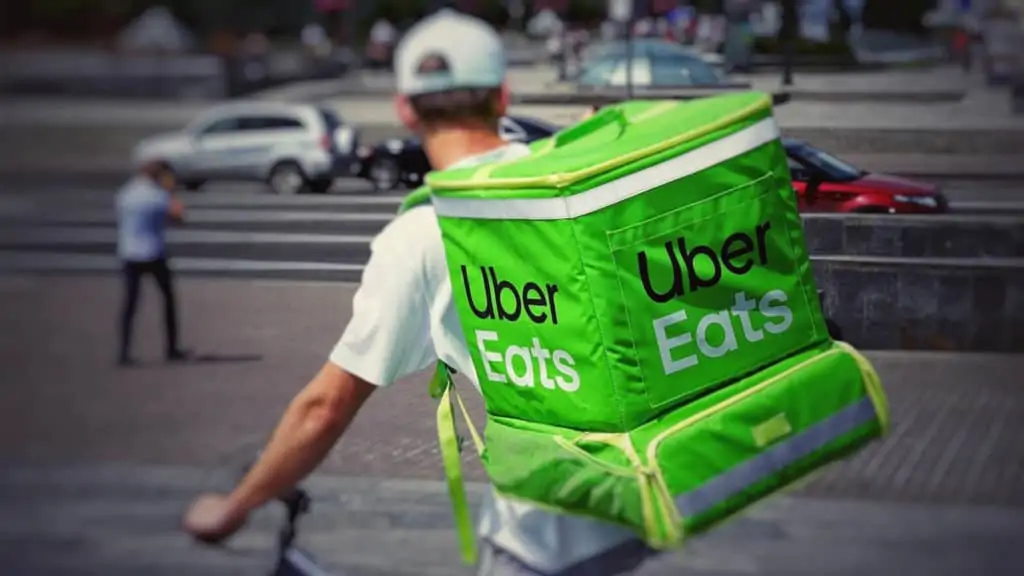This post may contain affiliate links – which means we may receive compensation from purchases made through links on this site. Learn more ›
Over the past few years, the food delivery industry has seen a significant boom in popularity. That’s because more people are choosing to eat at home rather than going out to restaurants.
Because of that, there has been a massive increase in opportunities for gig workers in the delivery sector. That’s why Uber began operating its online food ordering and delivery services.
So, when looking for a quick way to make extra pocket money, you may want to try driving for Uber Eats. If this sounds interesting to you, then you’ve come to the right place.
In this article, we’ll walk you through everything you need to know about working for the delivery service. We’ll cover how to use the app to help you out and tips and tricks to maximize your earning potential.
- What Is Uber Eats?
- How Does Uber Eats Work for Drivers? (An Overview)
- Understanding the Uber Eats Driver App
- The Basics of Uber Eats Pickups and Dropoffs
- How Scheduling Works for Uber Eats Drivers
- Understanding Uber Eats Driver Pay
- Safety and Support
- Community and Driver Resources
- Pros and Cons of Driving for Uber Eats
- The Hidden Frustrations of Uber Eats
- Conclusion: Is Uber Eats Worth It?
- Frequently Asked Questions
What Is Uber Eats?
Uber Eats is an incredibly popular food delivery platform that revolutionized the way people order and receive their meals. The story of the service starts in 2014.
At the time, Uber was the world’s leading raid-hailing business. Yet, the company was looking to expand its operations. Because of that, Uber decided to mobilize its fleet to deliver more than humans.
When it was first introduced, it was an add-on to the Uber app. Then, as more people started using the delivery service, the business launched a stand-alone platform. This gave us the Uber Eats we all know and love today.
The idea behind the service is simple yet effective.
Users can download the app on their smartphones and use it to browse all the restaurants and cafes in their vicinity. Once they choose a dining establishment, they can order any meal available on the menu.
Plus, users can track the progress of their orders in real-time. The application will give them information about the status of your food, along with the location of the driver delivering their order.
Aside from helping users get their food, Uber Eats has created countless job opportunities. People can sign up to become drivers with the business and deliver food to various locations.
In the following sections, we’ll talk about the food delivery service and help you decide if working for Uber Eats is worth it. If becoming an Uber Eats driver sounds like a good idea to you, there are a few basics you need to know to get started.
How Does Uber Eats Work for Drivers? (An Overview)
Delivering for Uber Eats is very simple. Uber Eats provides drivers with the ability to earn money without picking up people. Instead, you get to drive by yourself, listen to your favorite tunes, stroll into and out of restaurants, and make hand-offs to hungry folk. With a little time, you’ll easily learn.
Summary of Uber Driving
- As a driver, you log into the driver version of the Uber delivery app.
- Your app gets pinged if you are near the restaurant where a customer just placed an order.
- The app tells you the name of the restaurant and its address.
- You drive to the restaurant, pick up the food, and then deliver it to your customer.
Understanding the Uber Eats Driver App
Right off the bat, you have to learn how to use the Driver App. This app is your bridge to Uber Eats earnings – this includes pickups, dropoffs, and getting help as a driver.
Once you’ve downloaded the Uber Eats driver app, go to your map and tap the status bar at the bottom of the screen. Find the settings icon and navigate to the Driving Preferences tab.
There, you can tap on Deliveries to activate the Uber Eats service on your app. With that, you should be ready to make your first food delivery run.
Besides that, the platform will give you a few navigation options. You can choose to use Google Maps or Waze to get directions instead of the Uber app.
On top of that, the user interface is exceptionally clear and intuitive. With one click of a button, you’ll get details like:
- Restaurant name
- Customer address
- Estimated delivery time
The app also offers a few extra features to help you keep track of your work.
For instance, there’s an earning tracking service that’ll help you keep an eye on your Uber Eats payment schedule. This feature will allow you to choose the periods you’re available to make deliveries.
Once you understand the basics, it is time to go online. Once you do, you’ll start receiving orders right away. The Uber app will ping you every time there’s a delivery in your area.
For an in-depth look at how this app works for drivers, watch the training video below from our friends over at The Rideshare Guy:
The Basics of Uber Eats Pickups and Dropoffs
After opting into Uber Eats and receiving approval, which typically takes a few days, you can start accepting delivery requests. Activate your availability in the Uber Driver app by tapping “GO,” and you’ll soon receive orders from nearby restaurants.
Each delivery trip comes with essential details including the customer’s name, a breakdown of the Uber Eats fee, the order number, estimated time for restaurant arrival, and your potential earnings for the trip.
Delivery Options
Within these requests, there are two primary types of deliveries you’ll encounter:
- Curbside Deliveries: Here, the customer is notified to meet you outside, allowing you to remain in your car and hand over their order, simplifying the process by eliminating the need for parking and searching for the customer.
- Walk-In Drop-Off Deliveries: This more traditional approach requires you to deliver the order directly to the customer’s door, whether at an office, lobby, or residential location. Keeping the customer informed of your arrival can improve their experience and may lead to better tips.
Occasionally, multi-restaurant trip requests might come through, involving pickups from different locations.
Restaurant Pickups
On arriving at a restaurant, secure parking and proceed inside. Look for designated Uber Eats areas to expedite the pickup process. Collect the food by providing the order name from the app, and then head to the customer’s location.
For navigation, either use Uber’s integrated map system or opt for external apps like Waze or Google Maps.
Post-pickup, the customer may choose between direct handoff, contactless delivery, or meeting at your vehicle. You can take a photo of the order at drop-off as proof of delivery.
Finally, complete the delivery in the app, potentially receiving tips and new trip suggestions soon after.
How Scheduling Works for Uber Eats Drivers
As an Uber Eats driver, you enjoy a high level of flexibility in setting your own schedule.
Unlike other delivery apps such as DoorDash, which require specific scheduling, Uber Eats allows you to work on your own terms. You can start earning simply by turning on the app whenever you’re ready, without the need for advance scheduling.

You have the freedom to work as often as you like, with the option to work up to 15 hours in a day. However, to ensure driver safety and well-being, Uber Eats imposes certain limitations on shift lengths.
The platform doesn’t allow more than 12 consecutive hours of work. If the app remains active for 12 straight hours, it will automatically shut off, and you won’t be able to log back in until after a 10-hour break.
This also applies to cumulative working hours; for example, if you work for six hours, take a three-hour break, and then work another six hours, Uber will count this as a 15-hour working day and will enforce a break.
These rules are designed to prevent overwork and ensure that drivers get enough rest, including necessary sleep.
Overall, while Uber Eats provides great flexibility in how and when you work, it also maintains specific guidelines to promote safe and healthy working conditions.
Understanding Uber Eats Driver Pay
Uber Eats drivers generally earn between $15 to $20 per hour, but since payment is made per order, earnings can vary based on several factors.
To grasp how Uber Eats calculates driver pay, it’s important to understand the components of their payment structure. The compensation formula can be complex, so for simplicity, we’ll divide it into five key sections for easier comprehension.
1. Base Fare
The first part of the Uber Eats pay equation is the base fare. To calculate this, Uber employs a dynamic pricing algorithm that adjusts rates based on many variables. These include:
- Distance of your route
- Traffic
- Current user-to-driver ratio
Plus, the time you spend delivering orders will also affect the base fare. That’s why it’s a little tricky to calculate your exact earning potential.
2. Trip Supplement
Aside from the base pay, drivers get additional incentives to complete trips. For example, they’ll get compensated for the extra time or distance they had to cover.
On top of that, during periods of high demand, drivers get paid more for delivery requests.
3. Promotions
Uber Eats uses promotions to encourage drivers to complete more deliveries efficiently. One such promotion is Boost+, which offers extra pay for trips starting in designated areas during specified times.
Additionally, Uber Eats runs numerous quest promotions. These promotions reward drivers with increased earnings for completing a set number of trips within a specific timeframe. The more trips a driver completes, the higher their potential earnings.
For instance, completing 30 trips in three days might earn an additional $100 bonus, while completing 45 trips over four days could increase the bonus to $150. These incentives are designed to motivate drivers to take on more delivery requests.
Pro Tip: To unlock these promotions, apply an Uber Eats promo code during signup.
4. Tips
When customers order food via Uber Eats, they have the opportunity to tip their delivery driver either before or after receiving their order through the app. Fortunately, the delivery person retains the entirety of these tips.
Your overall earnings as an Uber Eats driver are determined by a combination of factors: base fare, trip supplement, promotions, and tips. However, each of these elements can vary based on a range of variables, making it somewhat challenging to calculate your exact profit margin.
5. Surge Pricing
The number of deliveries you complete in a day significantly influences your earnings with Uber Eats, as more orders lead to higher income. However, other factors also impact your earnings.
One key factor is surge pricing, which comes into play during times of high demand, typically around lunch and dinner hours. During these peak periods, Uber Eats implements surge pricing for users, resulting in higher pay per delivery for drivers.
Additionally, local market conditions also affect surge pricing, meaning that driver rates can vary depending on the city in which you
Safety and Support
Many people think that working for an organization like Uber Eats can be a little daunting. That’s because you’re out alone on the road all day, seemingly without anyone to ask for help.
Yet, that’s not the case. After becoming an Uber Eats driver, you’ll get access to all sorts of guidance.

If you ever need assistance while out on a delivery, you can contact the support team. All you have to do is launch your Uber app and click the menu icon.
Then, look through the settings until you locate the Help tab. There, you’ll find a list of common issues that drivers may face.
These include complications like:
- Difficulty navigating to a specific location
- A client complaining about a missing item in their order
- The restaurant is taking too long to prepare an order
Clicking on any of these items should give you a straightforward answer as to how to best deal with the problem. Yet, if you prefer a more human touch, you can use the call feature to contact a support agent directly.
Moving on, Uber Eats implements many safety protocols to ensure your security as a driver. To begin with, all deliveries use GPS tracking.
For that reason, if anything happens during your trip, there’s a full record of where you are and how you got there. This ensures that you won’t remain stranded for long in case of an emergency.
Other than that, Uber Eats will keep all your information private. The platform can’t reveal your phone number, social security number, or address to any of its users.
Finally, Uber Eats offers a commercial insurance policy with $1 million of coverage per incident. So, in the event a driver crashes their car while completing an order, the business will help you cover the repair expenses.
These safety protocols make the platform one of the top delivery services in terms of protecting its drivers. In fact, many drivers feel like working for Uber Eats is better than driving with DoorDash.
Community and Driver Resources
Working as an Uber Eats driver can be a tad alienating. You spend most of your day alone, driving around from one restaurant to the next.
In addition, you don’t get to interact with other drivers often. This can make gauging how well you’re doing a tough challenge.
Fortunately, there’s a way around this issue. There are countless community forums and groups on social media platforms that specifically cater to Uber Eats drivers.
These support groups allow delivery people to talk about their experiences driving around and delivering orders. People can talk about dealing with harsh clients or about the best way to navigate a certain area.
Plus, food delivery drivers can share tips on how to maximize your route to boost your earning potential.
Besides that, Uber provides a few resources to help you get started as a driver. This includes a list of dos and don’ts and a guide on how to receive payment.
Pros and Cons of Driving for Uber Eats
Working as an Uber Eats driver has its upsides and downsides. Some aspects of the job may be enjoyable, while others could be seen as drawbacks. It’s crucial to weigh both the pros and cons for a comprehensive view of the role.

You work for yourself as your own boss
Set your own schedule
Most customers help you earn more by leaving tips
You won’t experience rude riders or awkward discussions with weird riders
Decide to work longer hours when you need to earn more money
Explore your city and learn about what’s around you
You can get paid every single day
Busy restaurants sometimes make you wait for a long time when picking up
You’ll experience significant car expenses, such as gas, new tires, and repairs
Finding a public restroom can sometimes cause frustration
You might not find parking at restaurants
Traffic sometimes causes you to perform fewer trips per hour
Some customers stiff you on the tips
You might encounter rude restaurant employees
The Hidden Frustrations of Uber Eats
As mentioned above, you’re sure to discover some undesirable aspects of working as an Uber Eats driver. Here are three specific situations to be aware of.
1. Waiting to Be Matched With Orders
During certain times of the day, you might experience slow periods without any delivery requests, which can be frustrating. It’s not uncommon to find yourself waiting by the roadside, realizing you’re not earning because you haven’t had a trip in quite some time.
Mental preparation for these lulls is important, as they can be demoralizing if you dwell on them too much.
To avoid getting overwhelmed during these quieter moments, it’s helpful to have something productive or enjoyable to do. Whether it’s reading a book, watching a movie on your phone, or catching up on study materials, these activities can make the wait less taxing.
Since you won’t have passengers, you can easily keep your study materials or other items in the back seat, ready to use during these downtimes, without worrying about clutter when your next delivery request comes through.
Remember, every Uber Eats driver goes through this at some point, so you’re not alone in this experience.
2. Waiting at Restaurants for Food
This situation can be particularly challenging for an Uber Eats driver.
Picture this: you receive a new delivery notification, drive quickly yet safely to the restaurant, and hurriedly find parking. You rush into the restaurant, only to be told that your order will take longer than expected.
The phrase “a bit longer” often turns out to be much longer than anticipated, leading to a frustrating and potentially stressful wait.
This delay can cause concern about how the customer might react. Questions may arise, such as whether the customer will be upset about the delay, hold you responsible, or even reduce their tip due to the restaurant’s slow service.
The best approach in this scenario is proactive communication. Reach out to the customer via call or text to explain the situation. This can help them understand that the delay is beyond your control and not a reflection of your service.
3. Waiting at Doors for Customers
Driving for Uber Eats occasionally presents a significant frustration: customers not being promptly available for their deliveries.
Imagine you’ve arrived at the customer’s location, and they’ve chosen to meet you at your car. You find yourself waiting endlessly, wishing you could be elsewhere, perhaps even at home with your family.
Or, in another scenario, the customer has requested door delivery. You climb the stairs, knock on their door, and wait. After more knocking, texting, and calling, the customer finally appears, casually asking if you’ve been waiting long.
Fortunately, Uber Eats provides a solution for such situations. You can use the app to indicate that the customer hasn’t arrived, which starts a 10-minute countdown.
If the customer fails to show up within this timeframe to claim their food, you’re allowed to either leave the food at their door or take it with you, ensuring that your time isn’t wasted indefinitely.
Conclusion: Is Uber Eats Worth It?
Uber Eats presents a flexible and rewarding option for earning extra income, especially popular amid the increasing trend of home dining.
Drivers typically earn $15 to $20 per hour, with the ability to work up to 15 hours a day, though earnings can fluctuate due to various factors like base fare and surge pricing. The service offers the ease of app-based ordering and the choice between curbside and walk-in deliveries.
While it provides the advantage of flexible hours and the chance to explore the city, challenges like inconsistent waiting times and car-related expenses do exist. Effective communication with customers is key, especially during slower times or delays at restaurants.
In essence, Uber Eats offers a valuable opportunity for those who are equipped to handle its unique challenges and frustrations. For those who aren’t we’d suggest another side hustle like freelance writing.
Frequently Asked Questions
Once you apply for Uber Eats and are approved to drive, it’s easy to start making money on the road, and your work schedule is completely up to you.
To learn more about courier requirements, read these FAQs:
Can I drive for multiple food delivery apps at once?
Yes, you can drive for multiple food delivery apps simultaneously, like Uber Eats, Postmates, and Grubhub. This approach can maximize your earnings by increasing the frequency of back-to-back delivery requests. However, remember to go offline on other apps once you accept an order to avoid overlapping notifications and tasks.
Can I deliver for Uber Eats and drive for Uber?
Yes, you can simultaneously deliver for Uber Eats and drive for Uber. Uber allows eligible drivers to handle both passenger transport and food delivery requests within the same shift using the Uber driver app.
Drivers can choose to enable or disable this feature based on their preference, but it’s common for UberX drivers who meet age and vehicle requirements to do both for increased earnings potential.
Does Uber Eats Pay for Gas?
Unfortunately, Uber Eats won’t cover your basic expenses. That means drivers will have to pay for gas, car maintenance, repairs, and food delivery insurance.
This can take a major toll on the profits you stand to make. To reduce this burden, Uber offers temporary fuel surcharges every once in a while. The business will charge consumers extra, with 100% of that money going directly into the drivers’ pockets.
What Is the Uber Eats 100 Delivery Bonus?
Uber Eats 100 delivery bonus is a promotion similar to Boost+. If a driver manages to complete 100 trips in their first 90 days of employment, Uber will pay them $850 as an incentive. This encourages drivers to finish as many trips as possible in a short period.

